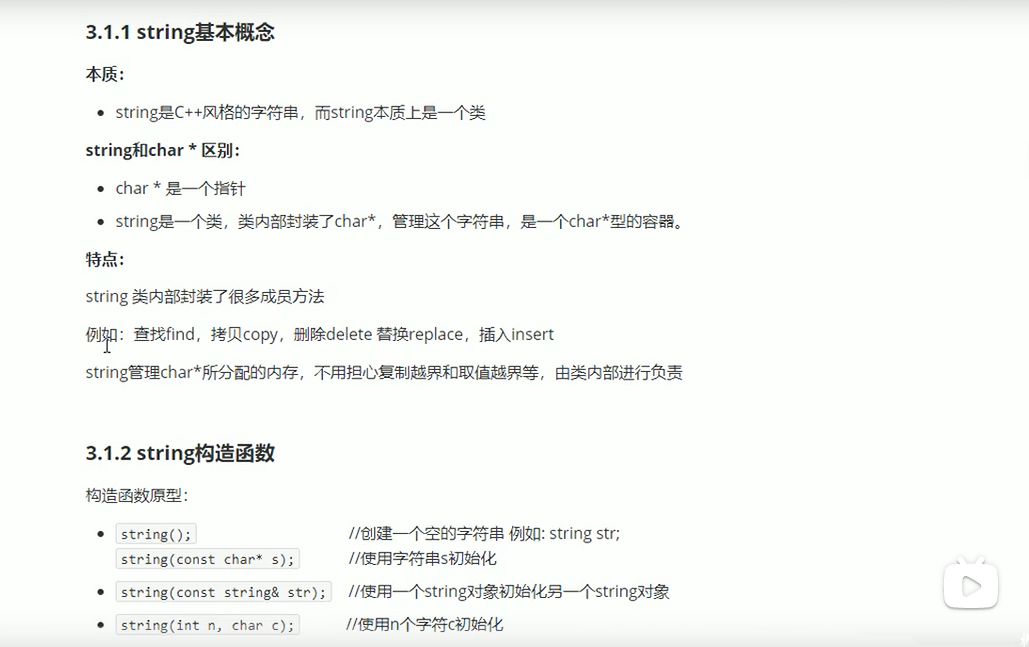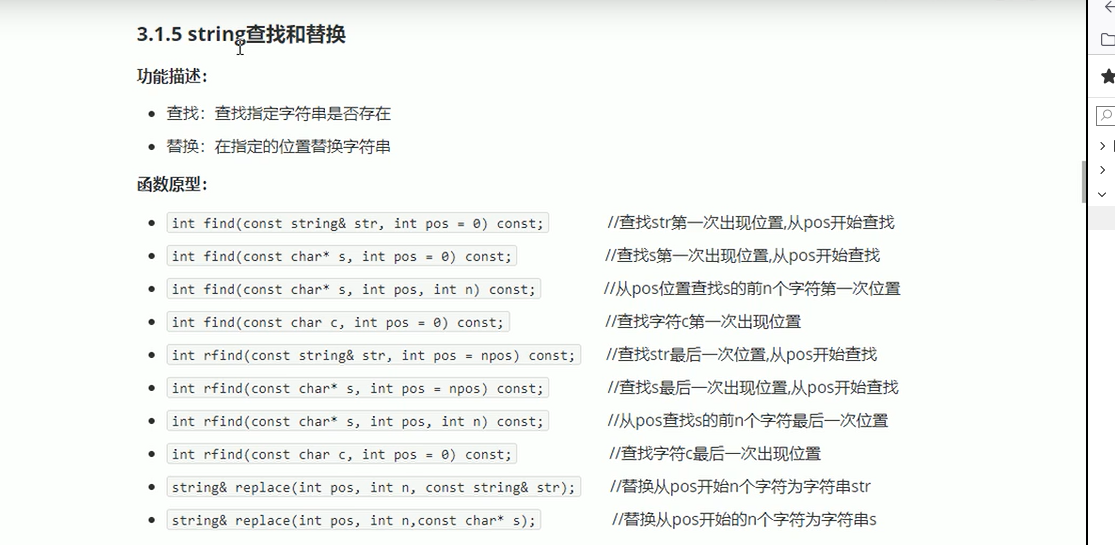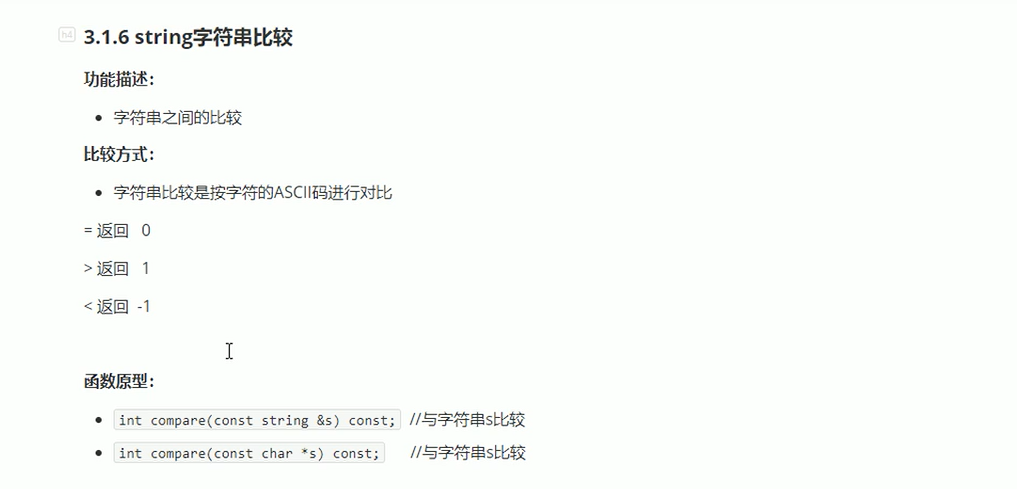
#include<iostream>
using namespace std;
#include<string>
//string的构造函数
//
//* `string(); ` //创建一个空的字符串 例如: string str;
//`string(const char* s); ` //使用字符串s初始化
//* `string(const string& str); ` //使用一个string对象初始化另一个string对象
//* `string(int n, char c); ` //使用n个字符c初始化
void test01() {
string s1;//默认构造
const char* str = "hello world";
string s2(str);
cout << "s2= " << s2 << endl;
string s3(s2);
cout << "s3= " << s3 << endl;
string s4(10,'a');
cout << "s4= " << s4 << endl;
}
int main() {
test01();
system("pause");
return 0;
}

#include<iostream>
using namespace std;
#include<string>
//string 赋值操作
//*`string& operator=(const char* s); ` //char*类型字符串 赋值给当前的字符串
//* `string& operator=(const string &s); ` //把字符串s赋给当前的字符串
//* `string& operator=(char c); ` //字符赋值给当前的字符串
//* `string& assign(const char *s); ` //把字符串s赋给当前的字符串
//* `string& assign(const char *s, int n); ` //把字符串s的前n个字符赋给当前的字符串
//* `string& assign(const string &s); ` //把字符串s赋给当前字符串
//* `string& assign(int n, char c); ` //用n个字符c赋给当前字符串
void test01()
{
string str1;
str1 = "hello world";
cout << "str1=" << str1 << endl;
string str2;
str2 = str1;
cout << "str2=" << str2<< endl;
string str3;
str3 = 'a';
cout << "str3=" << str3 << endl;
string str4;
str4.assign("hello C++");
cout << "str4=" << str4 << endl;
string str5;
str5.assign("hello C++",5);
cout << "str5=" << str5 << endl;
string str6;
str6.assign(str5);
cout << "str6=" << str6 << endl;
string str7;
str7.assign(10,'w');
cout << "str7=" << str7 << endl;
}
int main()
{
test01();
system("pause");
return 0;
}

#include<iostream>
using namespace std;
#include<string>
//字符串拼接
//* `string& operator+=(const char* str); ` //重载+=操作符
//* `string& operator+=(const char c); ` //重载+=操作符
//* `string& operator+=(const string& str); ` //重载+=操作符
//* `string& append(const char *s); ` //把字符串s连接到当前字符串结尾
//* `string& append(const char *s, int n); ` //把字符串s的前n个字符连接到当前字符串结尾
//* `string& append(const string &s); ` //同operator+=(const string& str)
//* `string& append(const string &s, int pos, int n); `/ / 字符串s中从pos开始的n个字符连接到字符串结尾
void test01()
{
string str1 = "我";
str1 += "爱玩游戏";
cout << "str1=" << str1 << endl;
str1 += ':';
cout << "str1=" << str1 << endl;
string str2 = "LOL DNF";
str1 += str2;
cout << "str1=" << str1 << endl;
string str3 = "I";
str3.append("love");
cout << "str3=" << str3 << endl;
str3.append(" game abcde",4);
cout << "str3=" << str3 << endl;
str3.append(str2);
cout << "str3=" << str3 << endl;
str3.append(str2,0,3);
cout << "str3=" << str3 << endl;
}
int main()
{
test01();
system("pause");
return 0;
}

```C++
//查找和替换
void test01()
{
//查找
string str1 = "abcdefgde";
int pos = str1.find("de");
if (pos == -1)
{
cout << "未找到" << endl;
}
else
{
cout << "pos = " << pos << endl;
}
pos = str1.rfind("de");
cout << "pos = " << pos << endl;
}
void test02()
{
//替换
string str1 = "abcdefgde";
str1.replace(1, 3, "1111");
cout << "str1 = " << str1 << endl;
}
int main() {
//test01();
//test02();
system("pause");
return 0;
}
```
总结:
* find查找是从左往后,rfind从右往左
* find找到字符串后返回查找的第一个字符位置,找不到返回-1
* replace在替换时,要指定从哪个位置起,多少个字符,替换成什么样的字符串

//字符串比较
void test01()
{
string s1 = "hello";
string s2 = "aello";
int ret = s1.compare(s2);
if (ret == 0) {
cout << "s1 等于 s2" << endl;
}
else if (ret > 0)
{
cout << "s1 大于 s2" << endl;
}
else
{
cout << "s1 小于 s2" << endl;
}
}
int main() {
test01();
system("pause");
return 0;
}
```
总结:字符串对比主要是用于比较两个字符串是否相等,判断谁大谁小的意义并不是很大

```C++
void test01()
{
string str = "hello world";
for (int i = 0; i < str.size(); i++)
{
cout << str[i] << " ";
}
cout << endl;
for (int i = 0; i < str.size(); i++)
{
cout << str.at(i) << " ";
}
cout << endl;
//字符修改
str[0] = 'x';
str.at(1) = 'x';
cout << str << endl;
}
int main() {
test01();
system("pause");
return 0;
}
```
总结:string字符串中单个字符存取有两种方式,利用 [ ] 或 at
#### 3.1.8 string插入和删除
**功能描述:**
* 对string字符串进行插入和删除字符操作
**函数原型:**
* `string& insert(int pos, const char* s); ` //插入字符串
* `string& insert(int pos, const string& str); ` //插入字符串
* `string& insert(int pos, int n, char c);` //在指定位置插入n个字符c
* `string& erase(int pos, int n = npos);` //删除从Pos开始的n个字符
**示例:**
```C++
//字符串插入和删除
void test01()
{
string str = "hello";
str.insert(1, "111");
cout << str << endl;
str.erase(1, 3); //从1号位置开始3个字符
cout << str << endl;
}
int main() {
test01();
system("pause");
return 0;
}
```
**总结:**插入和删除的起始下标都是从0开始
#### 3.1.9 string子串
**功能描述:**
* 从字符串中获取想要的子串
**函数原型:**
* `string substr(int pos = 0, int n = npos) const;` //返回由pos开始的n个字符组成的字符串
**示例:**
```C++
//子串
void test01()
{
string str = "abcdefg";
string subStr = str.substr(1, 3);
cout << "subStr = " << subStr << endl;
string email = "hello@sina.com";
int pos = email.find("@");
string username = email.substr(0, pos);
cout << "username: " << username << endl;
}
int main() {
test01();
system("pause");
return 0;
}
```
**总结:**灵活的运用求子串功能,可以在实际开发中获取有效的信息







